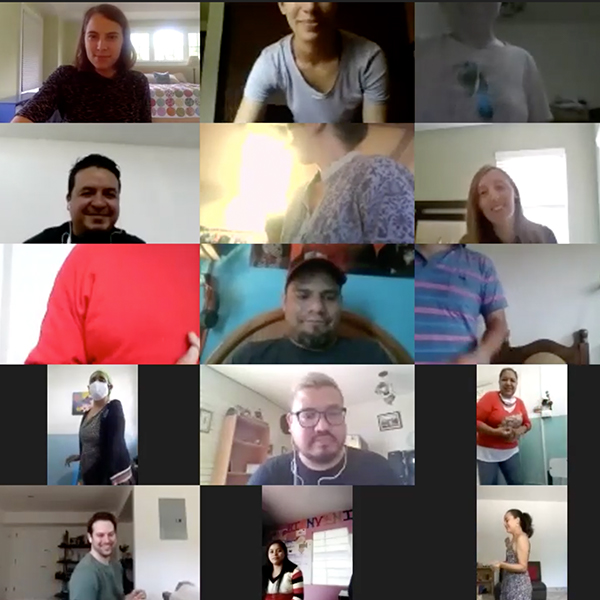Social media poses risks and challenges, but it can also be a powerful tool for youth activism. Here’s what GFC has learned about digital civic engagement.
During the pandemic, young people are finding innovative ways to connect, learn, and educate others about the issues that matter to them. Generation Z is transforming civic engagement and, with it, the world.
Most notable is the use of social media to connect and engage with like-minded peers and promote online civic engagement. Social media platforms such as Instagram, Twitter, and TikTok are becoming safe spaces for young people to speak out and initiate campaigns, including the Sunrise Movement and the Black Lives Matter movement. Hashtags, mentions, and direct messages make it easy for young people and organizations to interact and work together to create meaningful change.
In August, I hosted an internal Global Fund for Children meeting on the digital transformation of youth action. Our team gathered to discuss the benefits and drawbacks of online activism, digital strategies, and the latest evolution of youth activism.
The Power of Social Media to Spark Civic Discourse
On social media, young people are engaging in conversations about local and global issues such as migration, climate change, and healthcare. The wealth of online information makes it easy for young people to educate themselves and others about issues that are important to them and amplifies voices that might otherwise go unheard. Social media also creates opportunities to call out corruption and injustice, raise public awareness at a record-breaking pace, and form allies to fight for change.
“The pandemic has shown us alternatives as to how we can show our voices,” said Leni Alvarez, a member of GFC’s Youth Leadership Council and also part of the team at GFC partner Otros Dreams en Acción (ODA), an organization dedicated to mutual support and political action for and by those who grew up in the United States and now find themselves in Mexico due to deportation, the deportation of a family member, or the threat of deportation.
“At ODA, we have been able to build a transnational movement for the rights of deported and forcibly returned young migrants through social media,” Leni said.
Young people are also finding safe spaces online to connect with others who are like them or are facing similar challenges. Those who feel isolated or marginalized because of their identity or other challenges can find resources, information, and people they can relate to, forming connections and solidarity that can grow into political action. On TikTok, for instance, sisters Emma and Floli use fun dance videos to raise awareness about feminist issues, racism, and equal rights for all.
Digital Civic Engagement: Effective or INEFFECTIVE?
With so much online activism visible among today’s youth, a critical question is, “How does it translate into real life?” Online awareness raising and education does not necessarily effect change without in-person action. A major topic of discussion among the GFC team was online engagement facilitating “armchair activism” or “slacktivism,” a term for supporting a political or social cause solely through social media or online petitions, without expending much effort. Social media makes it easy for people to believe they are actively supporting a cause, without actually generating meaningful change. It can also disseminate misinformation.
“It’s kind of a double-edged sword,” said Maria Creamer, a Communications Officer at GFC. “Social media has the power to spark positive change but can also be used to spread misinformation.”
However, we are increasingly seeing young people translate online awareness raising to in-person activism. Twenty-nine-year-old Iih from Nepal used social media to gather youth for in-person peaceful protests against the Nepalese government’s approach to the COVID-19 pandemic. Iih’s social media campaigns have driven thousands of youth to the streets of Nepal’s main cities, putting pressure on the Nepalese government to enforce free COVID-related medical care and distribute accurate PCR tests. This is a powerful example of social media effecting social change and demonstrates that online engagement is a vital tool for activism today.
Partnering with Community-based Organizations for Social Change on Social Media
Around the world, GFC partners and young people in their communities are connecting via social media to call for change. For example, Coincidir, a GFC partner in Guatemala in the Empowering Adolescent Girls in Central America initiative, is engaging 75 girls and adolescents in a nationwide online campaign to advocate for policy changes to bring about more equitable technology access in rural areas so all children can participate in distance learning.

As part of its capacity development approach, GFC offers support and resources related to social media, digital video creation, and online safeguarding. In a digital world where trends are constantly changing, knowing the ins and outs of social media will remain critical to engaging young people as leaders and using social media strategically to create meaningful impacts in people’s lives.
Key Takeaways for Global Grantmakers:
- Facilitate the power of online communities: Social media is connecting young people from diverse communities like never before. As grantmakers, we can find out more about the latest trends in social media and digital activism, learning with our partners and young people. We can support training and resources that help community organizations build an online presence and base, enabling them to engage diverse audiences in advocacy.
- Encourage safety and mental health: While social media can provide safe havens for people to connect anonymously without fear of judgement, this same anonymity can place young people at risk of digital and in-person exploitation. Young people can also be targets of misinformation, and social media engagement can negatively impact young people’s mental health. Grantmakers can develop their own online safeguarding and digital security practices as well as offer resources.
- Translate online discourse into meaningful impact: Awareness about the risks and pitfalls of “armchair activism” can mobilize young people to true action, especially with opportunities for shared learning and skill building about social media engagement, relational organizing, policy change, and nonviolent action.
Header photo: With support from Coincidir, ten girls from Chimaltenango, Guatemala, traveled to Guatemala City to advocate for laws that promote free internet access in rural areas. © Coincidir


